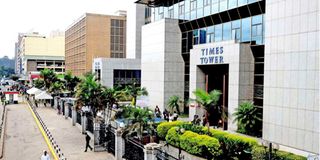Premium
Chinese imports cross Sh500 billion, amid KRA crackdown on tax cheats

Times Tower, the Kenya Revenue Authority's head office in Nairobi.
What you need to know:
- Imports from China were valued at Sh459 billion in 2023, a report by the Kenya National Bureau of Statistics shows.
- The surge in Chinese imports came at a time when the KRA directed all traders to pay taxes on their cargo per item.
Chinese imports crossed the half trillion mark for the first time last year, amid an aggressive crackdown on under-declaration of cargo with the Kenya Revenue Authority (KRA) directing traders to pay taxes per item and not through cargo consolidators.
Data from the national statistician shows that the value of imports from China rose by more than a quarter to Sh576.14 billion last year, the fastest pace since 2015 at the peak of shipment of construction materials for the Standard Gauge Railway (SGR), most of which came the Asian nation.
Imports from China—described as the factory of the world due to its industrial prowess—were valued at Sh459 billion in 2023, a report by the Kenya National Bureau of Statistics (KNBS) shows.
The surge in Chinese imports came at a time when the KRA directed all traders, including those who ship their goods through cargo consolidators, to pay taxes on their cargo per item as opposed to per kilogramme, which the taxman fears created an opportunity for mis-invoicing through the State had been losing billions of shillings in revenues.
With trade mis-invoicing, importers under-declare the price of an imported item, a practice that is common with consolidation of imported goods.
The crackdown against cargo consolidators started in July 2023, resulting a long-standing stand-off at border points, with small traders who deal in items such as mobile phones, laptops, toys or secondhand clothes taking the biggest hit.
“That bulk importation could have allowed high value item to enter at lower taxes,” said Dickson Magecha, a financial analyst.
Analysis of official trade data published separately by the separate tax authorities for the two nations—China and Kenya—has revealed a wide disparity in the value of imports from the Asian economic giant, raising concerns of mis-invoicing.
As part of its medium term revenue strategy, the National Treasury said the government will be working with other tax authorities in determining the true value of “high-risk imports from China” in what is aimed at addressing the problem of mis invoicing .
“Specific tax measures to be implemented include…to establish a clear framework on the exchange of information (EOI) with other tax jurisdictions for both domestic taxes and customs to ensure the flow of information e.g. valuation of high-risk imports from China and transfer pricing paused by multinationals,” the Treasury said in its Medium-Term Revenue Strategy for the period 2024-2027.
Kenya imports mostly television sets, large construction vehicles, clothes, and steel products from China.
Dealers in electronics, particularly mobile phones, were the most affected by the unbundling directive.
However, imports of mobile phones from China surged, with traders shipping into the country approximately 2.3 million smartphones in 2023, marking a 71.5 percent increase from the previous year's 1.3 million units, data provided by Chinese authorities shows.
Increased imports from China also come a time when manufacturers in the Asian nation were stuck with excess capacity following a bitter trade fall-out with the United States and Europe.
The high jump in imports from China in years 2014 and 2015 were mainly due to the construction of the first phase of the SGR from Mombasa to Nairobi started.
This major infrastructure project necessitated substantial imports of Chinese-manufactured materials and machinery boosting import volumes into Kenya.
With the competition of the first phase of SGR in May 2017, imports of China dropped by five percent the next year. It rose by 1.5 percent in 2019 as the extension of the SGR to Naivasha was started, then declined by four percent after its completion and closure of the economy to contain the spread of Coronavirus in 2020.
Beijing has doubled down on efforts to diversify its export markets, following imposition of high tariffs by the US, starting in the first term of Donald Trump, which were sustained by Joe Biden and escalated by Trump in his second term.
However, China has been on the look-out for alternative export markets, with some of this excess capacity filtering into Africa. African countries, including Kenya, have turned to China for affordable consumer products, such as electronics, textiles, and household items.
But Kenya also increasing its shipment of high-grade goods—especially electronics, machinery and cars—from China.
Dr Cavince Adhere, an expert on China-Africa relations, notes that there has been increased interest from Chinese businesses in Kenya, particularly the special economic zones (SEZs).
“In 2022 there were just about three companies in sez. By last year, there were 12 in Nairobi, Murang’a and machackos. That jump in no of cos investing here in SEZs, it is possible they could have imported a number of stuffs,” said Adhere.
The expansion of Chinese-owned retail chains, such as China Square, has influenced import patterns in the country by directly sourcing a wide array of products from China.
This direct importation model has intensified competition in the Kenyan retail market, affecting local traders and pricing structures.
China is Kenya’s leading trading partner, importing nearly everything from world’s second largest economy—from television sets and mobile phones to secondhand clothes and toys.
Dubbed the factory of the world, China has built one of the most robust industrial juggernaut that has seen it enjoy a trade surplus with nearly every country it trades.
The sharp increase in imports from China to Kenya starting in 2012 was primarily due to infrastructure projects like the SGR, strengthened bilateral relations, and the demand for cost-effective consumer goods.
However, this growth also been characterized by widening trade imbalances and killing of local industries which can’t compete with cheaper Chinese commodities.


